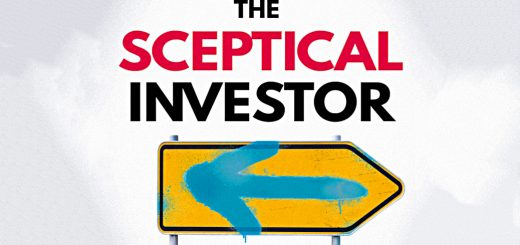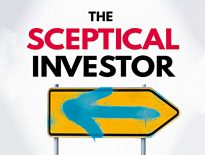The Sceptical Investor 1 – Contrarianism, Efficiency and Passives

Today’s post is our first visit to a popular UK investing book from last year – The Sceptical Investor by John Stepek.
Contents
John Stepek
John has been an investment writer for 20 years and will be best known to UK investors as one of the editors on MoneyWeek, a suitably contrarian publication for the author of a sceptical book.
His family owned a chain of electrical shops in Glasgow, and he started out by writing about family firms.
- He also studied psychology at university and is interested in the gap between theory and practice.
And now John has written a book.
Foreword
The foreword to the book is by Merryn Somerset Webb, the senior editor at MoneyWeek.
- She points out that investment should be simple (buy low, sell high) but it isn’t.
Most books present investment as a difficult activity and not for everyone (there are of course exceptions).
- She also notes the variety of methods that can be used to approach this super-exciting hobby: charts, momentum, growth, value.
None of this mattered much until recently, as company pensions looked after everyone.
- Now we have to fend for ourselves (unless we work in the public sector) and interest rates have been below inflation for a decade.
Merryn says:
Don’t be rigidly attached to any one idea or one method. Just be sceptical and careful.
That doesn’t mean being relentlessly pessimistic and it doesn’t mean always doing the exact opposite to what everyone else is doing (sometimes the crowd is right).
Contrarian investing
John says that all fund managers claim to be contrarians.
- That’s because contrarians are the heroes who may big bets that come off (Jesse Livermore, John Templeton, George Soros, the guys from The Big Short).
There’s a vague understanding that contrarian investors bet against the market. They “buy when there’s blood on the streets”. They “zig when the market is zagging”. They “buy what everyone else hates”.
The clichés are wrong in a very specific and harmful way. Putting the focus on what `the market’ is doing is profoundly wrong and goes a long way to explaining why many would-be contrarians lose money.
The point is that the market is often right, and even when it is wrong (as Keynes said) it can stay wrong for long enough for you to run out of money.
Contrarian investing is a mindset rather than a specific strategy, which is why it’s so hard to pin down.
John prefers the term “sceptical investing”.
What matters is the the size of the gap between the underlying `reality’ and the market’s perception of that reality.
John uses horse-racing as an analogy:
You can look at the horse’s diet, the form, the jockey - the `fundamentals’. But if you want to make money, you need to know what odds the bookies are [offering].
You won’t get rich by betting on the favourite every time.
- The trick is to spot when the rewards from the gap closing between the market perception and reality is bigger than the penalty of being wrong.
Market efficiency
John says that contrarian investing works because the prevailing view in the markets is that they are efficient.
I’m not sure that’s the case any more, though it was when I did my MBA 25 years ago.
- I would argue there’s a pretty lively debate around this (the active vs passive debate, even if a lot of the rhetoric is financially motivated).
Which is not to say that only 50% of people believing markets are efficient would invalidate John’s reasoning.
- For the record, both John and I (and many others) believe that the many bubbles, booms and busts of market history show that markets are clearly not efficient over significant time frames (several years).
But there isn’t a better alternative to sweep away the EMH, and so it persists.
- And liquid markets are pretty efficient over the long term:
If you buy a share today because your information makes you believe that its price should be higher, and your information is good then in the long run you’ll get paid (in the form of a higher share price).
Free markets offer a strong incentive to people to bring their best information and thinking to the table and share it around.
Reflexivity
John likes George Soros’ theory of reflexivity.
Soros recognises that the relationship between markets and the underlying reality is a two-way street. Financial markets “can affect the future earnings flows they are supposed to reflect”.
So as property prices rise, banks will lend more against property, which means more money goes into property, which make prices rise.
- We’re talking feedback loops here.
Another way of looking at this is price anchoring – the current price of a share (or a commodity) will impact what people think that company / asset is worth.
John also mentions Keynes’ beauty contest, where judges are invited to second-guess which woman other people will find most attractive.
- That’s essentially the stock-picking problem.
Investors spent all their time trying to outguess one another in their efforts to work out “what average opinion expects the average opinion to be”.
Markets help to shape the underlying reality, as well as the other way around. The two are constantly dancing a circle around one another, [and] they never match up.
EMH suggests that the market puts prices on companies in much the way that a thermometer measures temperature. Market practitioners understand that markets themselves are part of the system they measure.
John says that a reasonably efficient market can be produced by inefficient humans, so long as they all don’t think in the same way.
- Positive feedback loops are the ones to look out for, as they lead to bubbles.
Positive feedback encourages market participants to continue doing what they are doing and believing what they are believing.
And more people will notice, and jump on the bandwagon.
Soros says:
Even valid interpretations of reality are bound to give rise to distorted ones. Ideas that work well will be overexploited to the point where they do not work anymore.
The more an investment thesis is at odds with the generally prevailing view, the greater the financial rewards one can reap if it turns out to be correct.
John suggests that we start with the view that financial markets are always wrong.
Passive investing
John says that the logical conclusion of the ideas of the EMH is passive investing.
I think that this depends on what you mean by passive investing.
- The default implementation of “passive” investing is funds which track a market cap-weighted index.
This is neither passive nor efficient.
- The true EMH portfolio (or indeed, a suitable long-term buy and hold approach) is a volatility parity portfolio, similar to the one we have created through the “hand-crafting” process
- See The Perfect Portfolio for more details.
You could also include factor funds (smart beta) in a wider (and more efficient) definition of passive investing.
- John acknowledges that there is a semantic problem here.
Note that I’m not arguing with the basic premise that that investors as a group cannot beat the market, because they are the market.
- So funds underperform after fees and trading costs are deducted.
I also agree with John that most objections to passive investing come from the vested interests within the financial services industry (active managers in particular, but also analysts and IFAs).
- ESG investing looks like their latest wheeze.
But I believe that it’s possible:
- to beat the market, and
- to approach passive investing in better ways than market-cap allocations.
The 2008 crisis seems to have provoked a big shift towards passive, particularly amongst younger investors.
- I look forward (though that’s not quite the right phrase) to observing how these new recruits respond to the next crisis.
By 2017, passives had a 45% share in the US.
- I have some sympathy with the argument that passives blunt the ability of the market to allocate capital correctly.
But I am not convinced that this case is yet proven.
- And over the past decade, central bank actions (financial repression, QE etc) have had a much bigger impact.
Another criticism is that high passive ownership within a sector will blunt competition and give company management too much power.
- But government regulation of companies rather than funds (ie. watchdogs) is probably the way to address this.
The metagame
The metagame is John’s term for the way that you need to approach games of both skill and luck (say poker):
If you don’t pay attention to what’s going on in the heads of the players around you, you will struggle to beat them.
Where sceptics can gain an edge is by understanding how the one constant - human behaviour - interacts with changes [in technology, politics, investing mechanisms].
When people say: `It’s different this time’, it often is. But the one thing that does not change is human behaviour.
John offers three rules to help us think about how the switch to passive investing might affect us:
- Stability breeds instability
- This is just the positive feedback loop restated.
- The detail is that stocks are bought and sold on the basis of index membership.
- So those in the indices are more likely to be over-bought and those outside more likely to be oversold.
- This is basis of my argument against simple market cap investing.
- Follow the money
- John points out that as a product becomes popular, the interests of consumers and providers diverge.
- In the case of investment, this means that the ease of selling an idea is more important than the effectiveness of the underlying approach.
- The risk is that every new ETF becomes just another way to funnel money into the most popular stocks.
- Familiarity breeds contempt
- The third risk is complacency – passive investors are price-insensitive buyers.
- They might decide that they don’t need to understand what their funds are investing in.
- There are parallels here with the delegation of credit risk assessment to the ratings agencies in the run-up to the 2008 crisis.
That’s it for today, and it’s been a good start.
- It’s a fairly light and breezy book, but with plenty of solid content.
In the next article, we’ll look at the advantages of being a private investor, and at some behavioural economics.
Until next time.


















